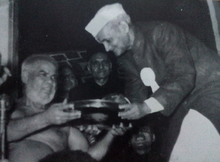
The Śvetāmbara is one of the two main branches of Jainism, the other being the Digambara. Śvetāmbara in Sanskrit means "white-clad", and refers to its ascetics' practice of wearing white clothes, which sets it apart from the Digambara or "sky-clad" Jains whose ascetic practitioners go nude. Śvetāmbaras do not believe that ascetics must practice nudity.

Acharya Vidyasagar was an influential Indian Digambara Jain acharya (monk), credited with having brought about a revival in educational and religious activities in Digambara Jainism. He wrote the epic Hindi poem Mukamati.

Acharya Shri Mahapragya was the tenth head of the Śvetāmbara Terapanth order of Jainism. Mahapragya was a saint, yogi, spiritual leader, philosopher, author, orator, and poet.
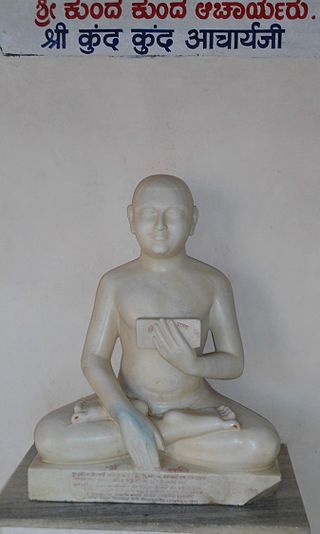
Jain monasticism refers to the order of monks and nuns in the Jain community and can be divided into two major denominations: the Digambara and the Śvētāmbara. The monastic practices of the two major sects vary greatly, but the major principles of both are identical. Five mahāvratas, from Mahavira's teachings, are followed by all Jain ascetics of both the sects. Historians believe that a united Jain sangha (community) existed before 367 BCE, about 160 years after the moksha (liberation) of Mahavira. The community then gradually divided into the major denominations. However, no evidences indicate when the schism between the Digambaras and the Śvetāmbaras happened.

Acharya Shri Shantisagar Ji (1872–1955) was an Indian Acharya of the Digambara monk faith. He was the first Acharya (preceptor) and a leader of his digamber sect in the 20th century. Shanti Sagar ji revived the teaching and practice of traditional Digambara practices in North India. He was lustrated as a kshullaka into the Sangha by Devappa (Devakirti) Swami Ji. He took his ailaka deeksha before an image of the Tirthankara Neminatha. In about 1920, Shantisagar Ji became a full muni (sadhu) of the Digambara. In 1922, at Yarnal village, Belgaum district, Karnataka, he was given the name "Shanti Sagar Ji".
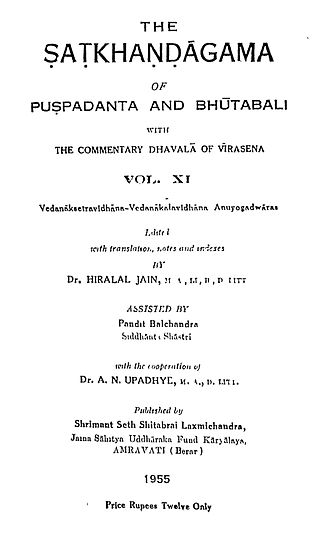
The Ṣaṭkhaṅḍāgama is the foremost and oldest Digambara Jain sacred text. According to Digambara tradition, the original teachings of lord Mahavira were passed on orally from Ganadhar, the chief disciple of Mahavira to his disciples and so on as they had the capability of listening and remembering it for always. But as the centuries passed there was downfall in these capabilities and so Ācārya Puṣpadanta and Bhūtabali penned down the teachings of Mahavira in Ṣaṭkhaṅḍāgama. Therefore the Ṣaṭkhaṅḍāgama is the most revered Digambara text that has been given the status of āgama.
Siddhasēna Divākara was a Jain monk of the Śvetāmbara sect in the fifth century CE who wrote works on Jain philosophy and epistemology. He was like the illuminator of the Jain order and therefore came to be known as Divākara, "Sun". He is credited with the authorship of many books, most of which are not available. Sanmatitarka is the first major Jain work on logic written in Sanskrit. Among the most popular of his works, the Kalyan Mandir Stotra is a Sanskrit hymn dedicated to the 23rd Tirthankara Parshvanatha. It is one of the 9 holiest recitations in the Śvetāmbara Murtipujak sect of Jainism.
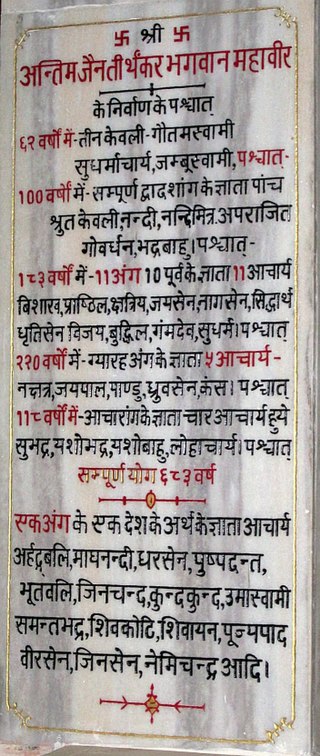
A Pattavali, Sthaviravali or Theravali, is a record of a spiritual lineage of heads of monastic orders. They are thus spiritual genealogies. It is generally presumed that two successive names are teacher and pupil. The term is applicable for all Indian religions, but is generally used for Jain monastic orders.

Jain literature refers to the literature of the Jain religion. It is a vast and ancient literary tradition, which was initially transmitted orally. The oldest surviving material is contained in the canonical Jain Agamas, which are written in Ardhamagadhi, a Prakrit language. Various commentaries were written on these canonical texts by later Jain monks. Later works were also written in other languages, like Sanskrit and Maharashtri Prakrit.
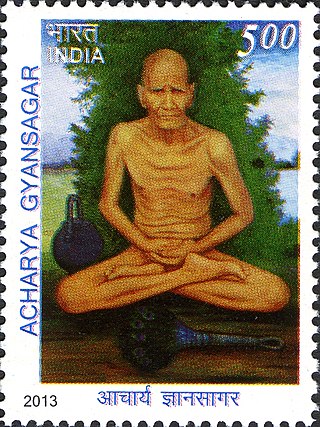
Acharya Jnansagar or Gyansagar (1891–1973) was a Digambara Jain Acharya of 20th century who composed many Sanskrit epics. He initiated Acharya Vidyasagar in 1968 as a monk and 1972 as an Acharya.
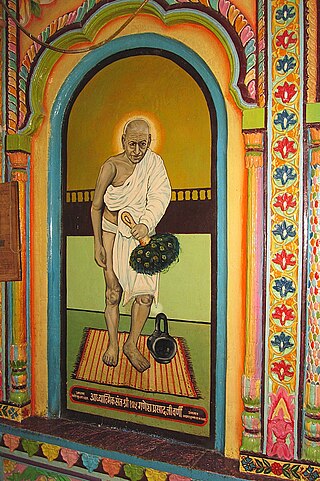
Kshullak Ganeshprasad Varni was one of the foundational figures of the modern Indian Digambara intellectual tradition during the early 20th century. He was the founder of several schools and institutions of advanced learning including Syadvad Mahavidyalaya at Varanasi in 1905, Varanasi and Satark-Sudhataringini Digamber Jain Pathshala, now Ganesh Digamber Jain Sanskrit Vidyalaya at Sagar.
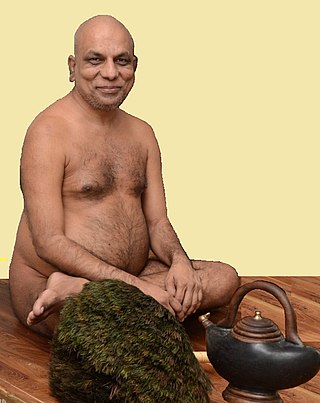
Munishri Pramansagarji Maharaj is a Digambar monk of Terapanth sub-sect. He is an able disciple of Acharya Shri Vidyasagar Ji Maharaj. He has set free the religion from traditional abstruseness and made it practicable in life. Through his sermons and initiatives, the process of a qualitative change in society has begun. He led a campaign to save the Jain tradition of Santhara also known as Sallekhana in the year 2015, in which millions of Jain community members took out massive silent rallies in several cities and towns all over the world against the Rajasthan High Court decision. Gunayatan is one of his important religious initiatives which is going to become a centre for self-development in the true sense. His pravachans and Shanka Samadhan programme are aired on Jinvani Channel and Paras TV Channel.

Gyanmati Mataji is an Indian Jain religious guru Aryika (nun) from India. She is known for being a prolific author and the construction of several Jain temples including the Jambudweep temple complex at Hastinapur, Uttar Pradesh, Ayodya Jain and the Statue of Ahimsa at Mangi Tungi in Maharashtra.

Upadhyaya Shri Guptisagarji is a Digambara monk who currently has the rank of an Upadhyaya. Born in 1957, he took ailak diksha under Acharya Vidyasagar ji in 1980, Muni diksha in 1982 also under Acharya Vidyasagar. He was initiated an Upadhyaya by Acharya Vidyanand ji in 1991. He is the inspiration behind Gupti Dham Jain Mandir, Ganaur, Sonipat.

Muni Shri 108 Kshamasagar ji Maharaj was a Digambara monk initiated by Shri 108 Acharya Vidyasagar ji Maharaj. He is also known for his poetry and writings which are widely quoted.

Siddhantacharya Pandit Phoolchandra Shastri was a Jain scholar, writer, editor, freedom fighter, social reformer and an intellectual giant in the field of Jainism. He is best known for dedicating a major part of his life in translating to Hindi the foremost and the oldest Digambara Jain Canon Shatkhandāgama and Kasayapahuda and its commentaries Dhavala, Maha-Dhavala and Jai-Dhavala. He was also an active member of Indian National Congress during the Indian freedom struggle. He was also a strong advocate and proponent of abolishing many evils within the Jain community. Panditji was also the founding member of many institutes of learning and scholarship. As a recognition of his contribution to Jain philosophy, he was conferred a title of "Siddhantacharya" at Jain Siddhant Bhavan, Ara (Bihar) in 1962 by the Governor of Bihar Ananthasayanam Ayyangar.
Vādikavi Ācārya Bappabhattisuri Mahārāja Sāheb was a Śvetāmbara Jain ascetic in the 8th century CE. He was an eminent poet, philosopher, reformer, researcher, and a child prodigy. Apart from his literary contributions, he is best known for his scriptural debates and the reforms he brought about in the iconography of Tirthankara idols sculpted and owned by the Śvetāmbara sect of Jainism.

Aryarakshitsuri was Śvetāmbara Jain monk and the founder of the Achal Gaccha of the Śvetāmbara sect of Jainism. He was a contemporary of Hemchandrasuri and is said to have met him.




